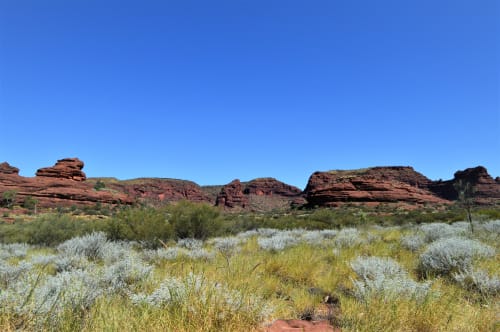The Western Arrernte community of Ntaria (Hermannsburg) is based at the remote foothills of the stunning Western MacDonnell ranges, 130 kilometres west of Alice Springs, Central Australia. The township itself is the home of approximately 700 people, and the hub for 37 regional outstations and homelands.
Hermannsburg’s contact history is rich and varied, and characterised by immense, rapid change.
From the late nineteenth century, the desert peoples and their landscapes, including their Dreaming animals and their sacred waterholes, began to be occupied by alien newcomers, as well as new economies. Cattle and sheep station leases were taken up and the famous Overland Telegraph Line, completed in 1872, signified Alice Springs as the major regional centre for the vast central desert. This contact was unequivocally violent: it is estimated that between 1881 and 1891, 700 Aboriginal people were shot in the areas around Alice Springs (Isaacs 2000, p.18).

“It seems there was always an expectation that the people at Hermannsburg would be adaptable. The impact of missionaries on their world was accompanied by an expectation for changing not only concepts of themselves, but also of almost every element of their lives.”
– TRISH BARNARD

Rapid economic and social shifts – as well as a severe drought – meant that the arrival or the Lutheran Missionaries offered the Arrernte/Luritja peoples a retreat from the violence of the frontier.
Offering protection, the missionaries had a profound and long-lasting influence on the direction of the Hermannsburg community and on the people of present day Ntaria. Of course, mission life came with a cost, and Aboriginal people were expected to change their worldviews by converting to Christianity and renouncing their own cultural practices. In exchange, the missionaries provided the regularity of a Christian way of life, including food, education and shelter. By 1904 the New Testament had been translated into Arrernte and the children of the mission learnt English, as well as Arrernte and German (Isaacs 2000, pp.18-21).
The missionaries in Hermannsburg, especially the pivotal contributions of the Albrecht family, have left an unquestionable legacy on the lives of the Arrernte. Pastor Albrecht oversaw the advent of a permanent water supply, new buildings and new education and training schemes. The arts were also strongly encouraged, including crafts, and eventually the Hermannsburg watercolour movement and later ceramics (Isaacs 200, p.25).

In 1975 the Aboriginal Land Rights movement lead the Mission to disable their institutional structures. In 1982 the land was handed back to the Traditional Owners and divided into five separate lease areas including the Ntaria Land Trust on which the township stands.
“Arrarnta people like to learn and work in new things. My grandmother learnt to crochet for the church, my uncles learnt watercolour painting, my grandmother Clara was Albert Namatjira’s half sister…And now, in this generation, we are first in pottery and we are travelling the world.”
– CLARA INKAMALA (HERMANNSBURG POTTERS)
Albert Namatjira’s success can in part be attributed to the desert people’s enduring adaptability and engagement with artists, including Rex Battarbee, during the mission period.
Namatjira was taught by teacher and friend Rex Battarbe, when Namatjira initiated some lessons after experiencing an exhibition of watercolour paintings in Hermannsburg 1934. Battarbee went on to open a gallery in Alice Springs in 1951. He continued to advise artists on technicalities of paintings. Namatjira went on to teach his family and kinsmen watercolour painting. Namatjira continued to paint his whole life, and by 1955 was internationally famous.
Namatjira is now internationally renowned as the first Aboriginal artist of the desert to work in contemporary media and paint European style landscapes. He was undoubtably the most famous Aboriginal person known throughout Aboriginal communities in his time.


While the first wave of Arrarnta artists were men, taught by Batterbee and Namatjira, pottery was introduced to Hermannsburg in the early 1970s by Victor Jaensch, from Barossa Valley. Jaensch advised on sourcing local clay, and built a small kiln. Two Arrernte teaching assistants, Nashasson Ungwanaka and Joseph Rontji, began the tradition of making sculptures from clay. These figures were painted and sold to tourists at the craft shop (Isaacs 2000, p.50).

These men were thus the first ‘Hermannsburg Potters’ and would go on to influence the development of artistic style of the current generation of women Potters.
In addition the current generation of Potters are strongly influenced by Namatjira’s depiction of Country, as well as his modern use of style. Many of the present day Potters recall watching Albert Namtjira work and are associated with him either directly or by kinship.
